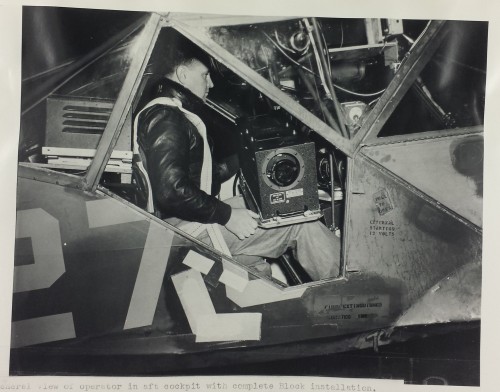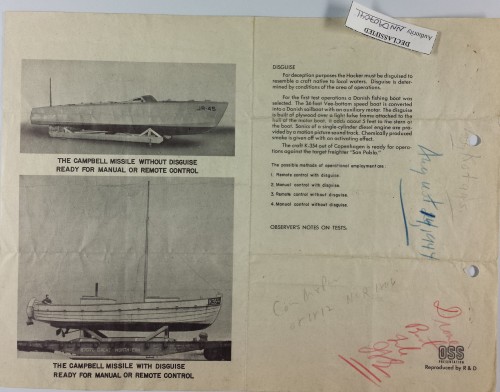One of the more interesting things in researching the end of World war II (WW2) in the Pacific is the way certain individuals or certain technologies keep showing up over and over again. Whenever flame tanks come up in Pacific histories, you find the name Col. George Unmacht. When you see the Brodie Device, Lt and later Captain Brodie is not far behind. This is pattern is something most academic diplomatic or military history researchers miss, either because their various thesis’s are too narrow to see that pattern for them. Or if they do, it is an exercise in minutia that doesn’t make the cut. This is a great loss to the general public.
Fortunately for you, I’m not an academic and I like what they consider minutia.
It turns out in Ryan Crierie and my latest adventures through the record groups in the National Archives and Records Administration (NARA), found one of those discarded patterns, in spades, with Dr. Vladimir Zworykin’s Block III television technology. The technology crossed over from the General Douglas MacArthur’s Pacific Warfare Board, to the ‘Sphinx Project’ files of the US Army’s New Developments Division in the Pentagon, to Army Air Force Records Group 18 (RG18), to Secretary of War Stimson’s RG107 “secret consultant” files of Dr. W.B. Shockley and then, finally, to the US Navy’s Secret Weapons files. The darned thing showed up everywhere, to include the cancelled by Japanese surrender Cadillac III Airborne Early Warning (AEW) planes as a data down link. This “Where’s Waldo” performance across NARA explained a number of questions Ryan and I both had on how the heck MacArthur got what amounted to a crewed UAV surveillance system

According to the US Army Air Force files, there were 2,500 of Zworykin’s Block III television seekers built for all the various War and Navy Department programs it was involved with by December 1944.

Zworykin’s Block III television seeker technology in the “TDR-1” piston engine guided missile and the similar towed missile “Glomb” (Glider-BOMB) needed a reusable platform, so they could test the expensive Block III equipment without destroying it. In test aircraft they found the Block III worked pretty well for seeing images up to 20 miles away. Then the development program people working for the Navy decided to try to find the smallest, cheapest airplane they could to do so. This turned out to be the Stinson L-5 Sentinel, also called the OY-1 in USMC service, a small plane in the Piper Cub class of ‘General Aviation’ aircraft.
This Block III technology in the L-5 was tested during amphibious exercises held at Santa Catalina Island off the Southern California coast. Not coincidentally, Catalina Island was also a secret commando training base for the Office of Strategic Services (OSS), who used the same Block III TV technology in the Campbell/Javaman remote controlled boat-bomb that was intended to attack the Japanese Kanmon Undersea Railway Tunnel in October 1945.

After those test successes, The L-5 Block III was placed in a special US Army/Office of Research and Development demonstration team and shown MacArthur to wide approval See my column “History Friday: Secrets of the Pacific Warfare Board — Block III TV in the Occupation of Japan, First of an Occasional Series.” It turns out there was more involved in the disappearance of the block III TV than the birth of the USAF.
The US Navy secret weapons files show that the Block III, a 1943 technology, was being replaced by more advanced 1944-45 technology Block 10 and Block 18 TV equipment with transmission capability in higher radio frequencies. The Block 10 was to replace some of the US Army Block III kit intended for the Invasion of Japan and the US Navy wanted to use the block 18 in their TBM torpedo planes that had been converted to photo reconnaissance work, in much the same way that today’s P-3 Orion patrol planes have in Somalia, former Yugoslavia, Iraq and Afghanistan over the last 20-years.

So ends another History Friday column in a Pacific War pattern of minutia, that wasn’t so minute, and was fun besides.
Notes and Sources —
http://en.wikipedia.org/wiki/Stinson_L-5_Sentinel
Exhibitions > First Line of Defense: Catalina Island and World War II
http://www.catalinamuseum.org/exhibitions_view.asp?nexhibition_ID={91B6AF5C-9C96-4A3F-B89C-EEBEB137A982}
Nathan Masters, Commandos and Anti-Aircraft Guns: Catalina’s Top-Secret WWII History, January 24, 2013
http://www.kcet.org/updaily/socal_focus/history/la-as-subject/spies-commandos-and-radar-catalinas-top-secret-wwii-history.html
Trent Telenko, History Friday: Secrets of the Pacific Warfare Board — Block III TV in the Occupation of Japan, First of an Occasional Series, June 20, 2014
Trent Telenko, History Friday: Operation Olympic Something Forgotten & Something Familiar, January 10, 2014
History Friday: Operation Olympic – Something Forgotten & Something Familiar
I’d love to know whether this is true.
http://www.futilitycloset.com/2014/08/12/operation-fantasia/
We seem to be having comment weirdness.
I can see some comments in the recent comment thread and one of them is missing from this post.
I think we’re back in business now. Apologies for the outage.
Sorry if this got lost — I had mentioned an article about the lack of fire support during the Normandy Landings and have finally found the publication. It is Spring 2003 MHQ, and is about George C. Marshall’s attempt to bestow the knowledge of landings in the Pacific to Normandy leaders. Major General Charles H. Corlett, (7th Division), went to England and was astonished to say the least. He basically said that none of the commanders preparing Overlord,especially Bradley, displayed the slightest inclination to learn anything from the amphibious experiences of the U.S. forces in the Pacific. He also warned of the critically low estimations of ammunition required to knock out targets.
There is much more in the article, but I have not had the chance to go through the writings of Williamson Murray (article author), or the documents of General Corlett. Good luck on the book as it sounds extremely interesting.